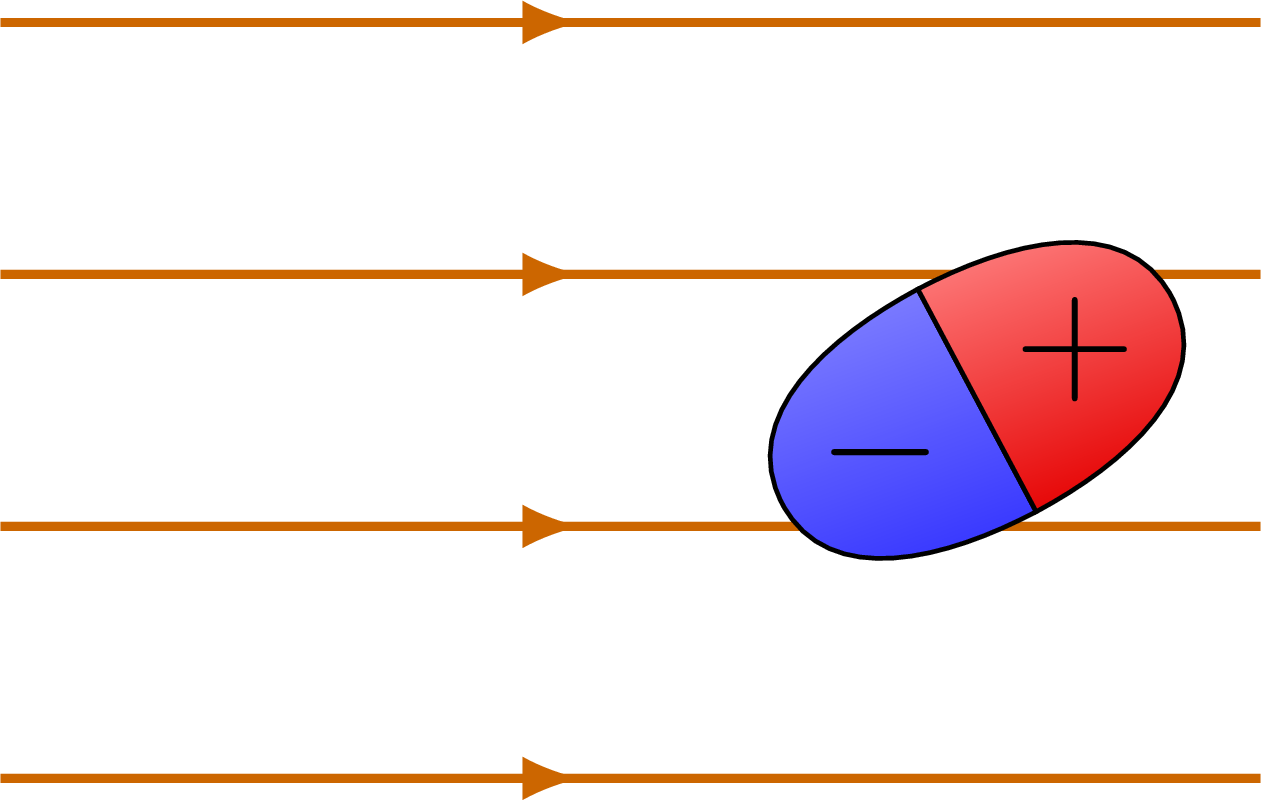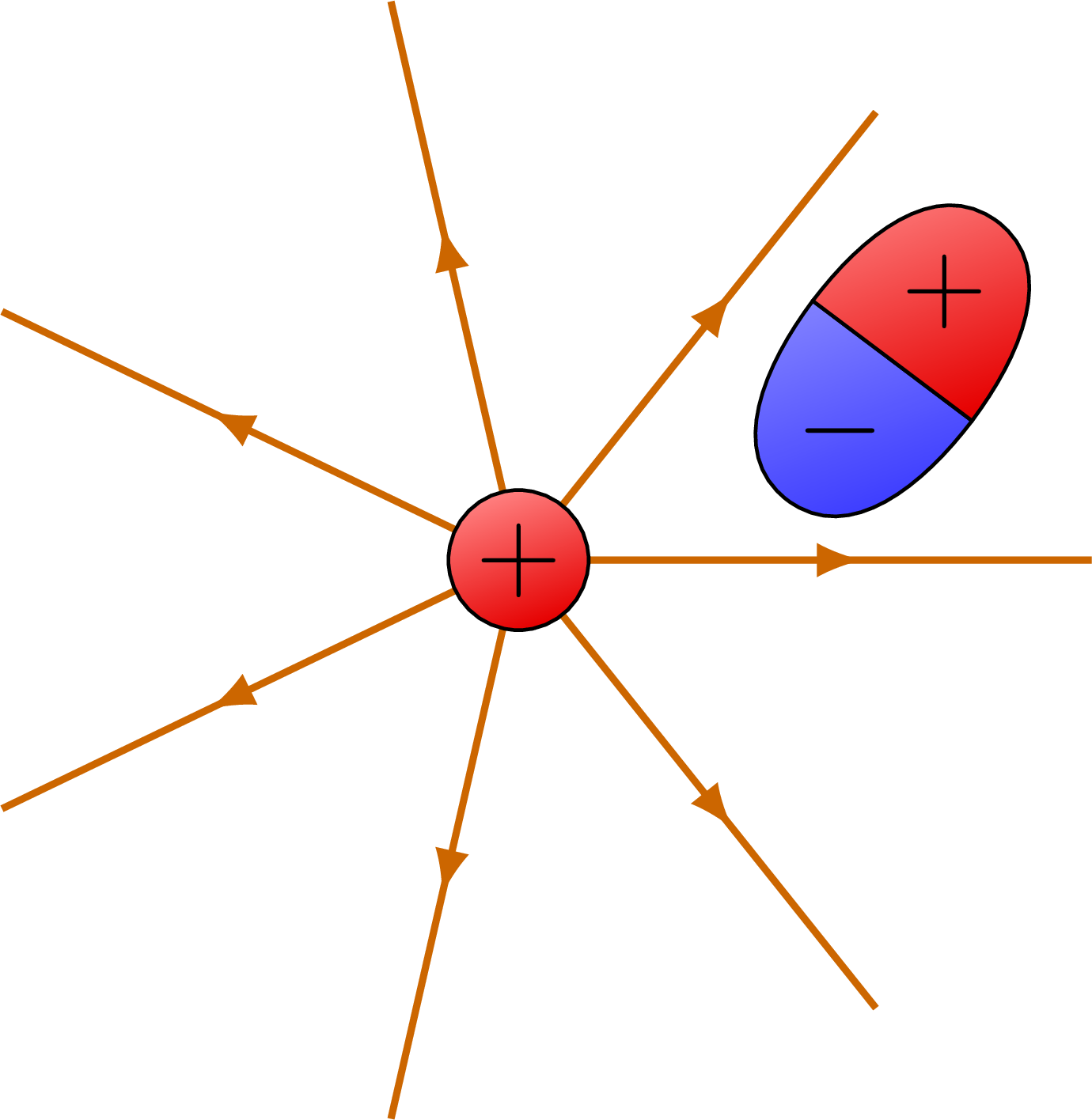Edit and compile if you like:
% Author: Izaak Neutelings (July 2018)
\documentclass[border=3pt,tikz]{standalone}
\usepackage{amsmath}
\usepackage{tikz}
\usepackage{physics}
\usetikzlibrary{intersections}
\usetikzlibrary{decorations.markings}
\usetikzlibrary{angles,quotes} % for pic
\tikzset{>=latex} % for LaTeX arrow head
\usepackage{xcolor}
\colorlet{Ecol}{orange!90!black}
\colorlet{EcolFL}{orange!80!black}
\colorlet{FCol}{red!60!black}
%\colorlet{charge+}{blue!80!white}
\colorlet{veccol}{green!45!black}
\tikzstyle{charge+}=[thin,top color=red!50,bottom color=red!90!black,shading angle=20]
\tikzstyle{charge-}=[thin,top color=blue!50,bottom color=blue!80,shading angle=20]
\tikzstyle{charge0}=[very thin,top color=green!80!black!50,bottom color=green!80!black,shading angle=20]
%\tikzstyle{charge+}=[thin,ball color=blue!60,shading angle=-10]
%\tikzstyle{charge-}=[thin,ball color=red!85,shading angle=-10]
%\tikzstyle{charge0}=[thin,ball color=green!80!black!80,shading angle=-10]
\tikzstyle{O}=[top color=red!60,bottom color=red!90!black,shading angle=10]
\tikzstyle{H}=[top color=white,bottom color=white!90!black,shading angle=10]
\tikzstyle{force}=[->,very thick,FCol]
\tikzstyle{vector}=[->,very thick,veccol]
%\tikzstyle{EFieldLine}=[thick,EcolFL,EcolFL,decoration={markings,
% mark=at position 0.5 with {\arrow{latex}}},
% postaction={decorate}]
\tikzset{
EFieldLine/.style={thick,EcolFL,decoration={markings,
mark=at position #1 with {\arrow{latex}}},
postaction={decorate}},
EFieldLine/.default=0.5}
\begin{document}
\Large
% DIPOLE
\begin{tikzpicture}
\def\R{0.48}
\def\L{4.0}
\coordinate (Q-) at ( 0,0);
\coordinate (Q+) at (\L,0);
\draw[vector] (Q-) ++ (\R,0) --++ (\L-2*\R,0) node[midway,above] {$\mathbf{L}$};
\draw[charge-] (Q-) circle (\R) node[scale=1.0] {$-q$};
\draw[charge+] (Q+) circle (\R) node[scale=1.0] {$+q$};
\end{tikzpicture}
%% DIPOLE
%\begin{tikzpicture}
% \def\R{0.48}
% \def\a{2.0}
% \coordinate (Q-) at (-\a,0);
% \coordinate (Q+) at (+\a,0);
% \coordinate (P) at (+2.5*\a,0);
%
% \draw[->,thick] (-1.5*\a,0) -- (+3.0*\a,0); %node[right] {$x$};
% \draw[thick] (0,0.1) -- (0,-0.1) node[below] {0};
% \draw[vector,line width=2] (Q-) ++ (\R,0) --++ ({2*(\a-\R)},0) node[midway,above] {$\mathbf{L}$};
% \draw[charge-] (Q-) circle (\R) node[scale=1.0] {$-q$};
% \draw[charge+] (Q+) circle (\R) node[scale=1.0] {$+q$};
% \fill (P) circle (0.1) node[above=2] {P};
% \node[below=12] at (Q-) {$-a$};
% \node[below=12] at (Q+) {$+a$};
% \node[below= 4] at (P) {$x$};
%
%\end{tikzpicture}
% DIPOLE - axis beneath
\begin{tikzpicture}
\def\R{0.48}
\def\a{2.0}
\def\h{0.7}
\coordinate (Q-) at (-\a,\h);
\coordinate (Q+) at (+\a,\h);
\coordinate (P) at (+2.5*\a,\h);
\draw[->,thick] (-1.5*\a,0) -- (+3.0*\a,0);
\draw[thick] ( 0,0.15) --++ (0,-0.3) node[below] {0};
\draw[thick] (-\a,0.1) --++ (0,-0.2) node[below] {$-a$};
\draw[thick] (+\a,0.1) --++ (0,-0.2) node[below] {$+a$};
\draw[thick] (2.5*\a,0.1) --++ (0,-0.2) node[below] {$x$};
\draw[vector,line width=2] (Q-) ++ (\R,0) --++ ({2*(\a-\R)},0) node[midway,above] {$\vb{L}$};
\draw[charge-] (Q-) circle (\R) node[scale=1.0] {$-q$};
\draw[charge+] (Q+) circle (\R) node[scale=1.0] {$+q$};
\draw[vector,line width=2,Ecol] (P) --++ (0.9*\a,0) node[above=2,above left=0] {$\vb{E}$};
\fill (P) circle (0.1) node[above=2] {P}; % node[below=2] {$x$};
\end{tikzpicture}
% DIPOLE in a uniform electric field
\begin{tikzpicture}
\def\M{4}
\def\xmax{2.0}
\def\ymax{2.0}
\def\a{0.7}
\def\b{0.4}
\def\ang{28}
% ELECTRIC FIELD
\foreach \i [evaluate={\y=-\ymax+2*\i*\ymax/(\M+1);}] in {1,...,\M}{
\draw[EFieldLine=0.46] (-\xmax,\y) -- (\xmax,\y);
}
% DIPOLE
\begin{scope}[shift={(1.1,0)},rotate=\ang]
\draw[thick,charge-] (-\a,0) to[out=90,in=180] (0,\b) -- (0,-\b) to[out=180,in=-90] cycle;
\draw[thick,charge+] ( \a,0) to[out=90,in=0] (0,\b) -- (0,-\b) to[out=0,in=-90] cycle;
\node at (-\a/2,0) {$-$};
\node at ( \a/2,0) {$+$};
\end{scope}
\end{tikzpicture}
% DIPOLE in a non-uniform electric field
\begin{tikzpicture}
\def\R{2.3}
\def\a{0.7}
\def\b{0.4}
\def\angle{53}
% FIELD
\foreach \i [evaluate={\ang=\i*360/7;}] in {0,...,6}{
\draw[EFieldLine={0.6}] (0,0) -- (\ang:\R);
}
\draw[charge+] (0,0) circle (8pt) node[black,scale=0.9] {$+$};
% DIPOLE
\begin{scope}[shift={(1.5,0.8)},rotate=\angle]
\draw[thick,charge-] (-\a,0) to[out=90,in=180] (0,\b) -- (0,-\b) to[out=180,in=-90] cycle;
\draw[thick,charge+] ( \a,0) to[out=90,in=0] (0,\b) -- (0,-\b) to[out=0,in=-90] cycle;
\node[scale=0.9] at (-\a/2,0) {$-$};
\node[scale=0.9] at ( \a/2,0) {$+$};
\end{scope}
\end{tikzpicture}
% DIPOLE MOMENT in a uniform electric field
\begin{tikzpicture}
\def\R{0.48}
\def\L{4.0}
\def\F{2.0}
\def\ang{28}
\coordinate (Q-) at ( 0,0);
\coordinate (Q+) at (\ang:\L);
\coordinate (X) at (\L,0);
\draw[force] (Q-) --++ (-\F,0) node[above] {$\vb{F}_-$};
\draw[force] (Q+) --++ (+\F,0) node[above] {$\vb{F}_+$};
\draw[vector] (Q-) ++(\ang:\R) --++ (\ang:\L-2*\R) node[midway,above left=1] {$\vb{L}$};
\draw[dashed,thick] (Q-) -- (X);
\draw pic[->,thick,"$\theta$",draw=black,angle radius=35,angle eccentricity=1.4]
{angle = X--{Q-}--{Q+}};
\draw[charge-] (Q-) circle (\R) node[scale=1.0] {$-q$};
\draw[charge+] (Q+) circle (\R) node[scale=1.0] {$+q$};
\end{tikzpicture}
% DIPOLE MOMENT in a non-uniform electric field
\begin{tikzpicture}
\def\R{0.48}
\def\L{4.0}
\def\F{2.0}
\def\ang{53}
\coordinate (Q-) at ( 0,0);
\coordinate (Q+) at (\ang:\L);
\coordinate (X) at (\L,0);
\draw[force] (Q-) --++ (155+\ang:\F) node[left=6,above] {$\vb{F}_-$};
\draw[force] (Q+) --++ (\ang-12:0.55*\F) node[above] {$\vb{F}_+$};
\draw[vector] (Q-) ++(\ang:\R) --++ (\ang:\L-2*\R) node[midway,above left=1] {$\vb{L}$};
\draw[dashed,thick] (Q-) -- (X);
\draw pic[->,thick,"$\theta$",draw=black,angle radius=28,angle eccentricity=1.4]
{angle = X--{Q-}--{Q+}};
\draw[charge-] (Q-) circle (\R) node[scale=1.0] {$-q$};
\draw[charge+] (Q+) circle (\R) node[scale=1.0] {$+q$};
\end{tikzpicture}
% WATER MOLECULE
\begin{tikzpicture}[scale=0.8]
\def\d{1.0}
\def\RO{1.3}
\def\RH{1.0}
\def\ang{104.5}
\coordinate (O) at ( 0, 0);
\coordinate (H1) at ( \ang/2:\d);
\coordinate (H2) at (-\ang/2:\d);
\coordinate (T1) at ( \ang/2:{1.1*(\d+\RH)});
\coordinate (T2) at (-\ang/2:{1.1*(\d+\RH)});
\path[name path=O] (O) circle (\RO);
\path[name path=H1] (H1) circle (\RH);
\path[name path=H2] (H2) circle (\RH);
\draw[O] (O) circle (\RO);
% \path[name intersections={of=O and H1, name=i}];
% %\draw (i-1) to [bend left] (i-2) to[out=140,in=-30,looseness=5] cycle;
% %\draw (i-1) to [bend left] (i-2) to[controls=+(110:3*\RH) and +(0:3*\RH)] cycle;
% %\draw (T1) -- (i-1) -- (i-2) -- cycle;
% \draw (i-1) to[bend left] (i-2) to[out=180,in=120] (T1) to[out=0,in=-60] cycle;
% %\draw[rotate=60] (i-1) --++ (0,\RH) --++ (0,+\RH) -- (i-2);
% \path[name intersections={of=O and H2, name=i}];
% %\draw (i-1) to [bend left] (i-2) to[out=0,in=-110,looseness=5] cycle;
% \draw (i-1) to[bend left] (i-2) to[out=60,in=0] (T2) to[out=-120,in=180] cycle;
% \draw (i-1) to [bend left] (i-2) --++ (150:0.1*\RH) --++ (60:1.2*\RH) --++ (-30:2.2*\RH) --++ (-120:1.2*\RH) -- cycle;
\begin{scope}
\path[name intersections={of=O and H1, name=i}];
\clip (H1) circle (1.1*\RH);
\clip (i-1) to[bend left] (i-2) to[out=180,in=\ang] (T1) to[out=0,in=-\ang/2] cycle;
\draw[H] (H1) circle (\RH);
\end{scope}
\draw[very thin] (i-1) to [bend left] (i-2);
\begin{scope}
\path[name intersections={of=O and H2, name=i}];
\clip (H2) circle (1.1*\RH);
\clip (i-1) to[bend left] (i-2) to[out=\ang/2,in=0] (T2) to[out=-\ang,in=180] cycle;
\draw[H] (H2) circle (\RH);
\end{scope}
\draw[very thin] (i-1) to [bend left] (i-2);
%\node[scale=1.1] at ( 180:0.3*\RO) {O};
%\node[scale=1.1] at ( \ang/2:1.2*\d) {H};
%\node[scale=1.1] at (-\ang/2:1.2*\d) {H};
\node[above left] at (170:0.92*\RO) {$\delta^-$};
\node[above right] at ( 35:{0.92*(\d+\RH)}) {$\delta^+$};
\node[below right] at (-35:{0.92*(\d+\RH)}) {$\delta^+$};
\end{tikzpicture}
\end{document}Click to download: electric_dipole.tex • electric_dipole.pdf
Open in Overleaf: electric_dipole.tex








